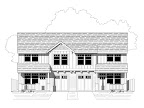Welcome back class to my lecture series on designing an economical to build house. I am your professor, Dr. Istockhouseplans. Last week we talked about designing a house that made good use of the 4' building material size and it's subsets, 24", 16", and 12". This week we'll talk a little more about advanced framing techniques to save even more money and time.
What are advanced framing techniques? They are a set of rules recognized by the International Residential Code as equivalent to standard construction. These rules lessen the amount of studs and headers that go in walls. They allow for more insulation. They make for homes that are easier to keep cool in summer and warm in winter.
The first AFT to consider is using studs not at 16" on center, but 24". 2x6 framing studs at 24" o.c. will support a 2-story house. So why do so many builders use studs at 16" o.c.? Because tradition runs deep. In fact, this tradition has been so ingrained into builders that many of them believe a house framed at 24" o.c. will be too flimsy. They couldn't be more wrong. The 'flimsiness' of a house has nothing to do with the spacing of the studs and everything to do with bracing. Framing at 24" o.c. allows for less studs, less nails, and a higher insulation to stud area, or less cold bridges. Cold bridges occur wherever insulation is not.
The second AFT is to not use 2x studs as wallboard backers where wall intersections occur. In a standard 3-stud corner, there is always an air pocket that insulation will either not fill, or fill under compression. Insulation can't do it's job when it is compressed. A better alternative is to use 1x backers, or even better, drywall stops. Drywall stops are easy to install and allow drywall floating along edges to reduce later cracking that comes with the house settling.
The third AFT has to do with headers. Why framers and designers feel compelled to put 4x12's over every single exterior wall opening, I do not know. Many openings could be supported with a 2x12 or even no header at all. Consider if your joists are running parallel to a window opening. You already are effecting a header with no tributary load. Why put another one in? That is a waste of time, lumber, and nails. If designers would take the time to call out 2x12 headers or no header required, millions of board feet of lumber a year could be saved, and thousands of manhours could be saved.
Headers create unnecessary cold bridges. When placing a 4x12 header in a 2x6 wall, there is a 2" void that can be filled with insulation. Using a 2x12 header will allow for more insulation. If no header is needed and it is less than 24" from the top plate, the whole space can be insulated without needing cripple studs.
Last week we discussed shifting doors and windows to use existing studs a king stud. If the opening is 3' wide (for most doors and some windows), no jack stud is needed and a framing clip can be used to support the header if one is even needed. Even with 6' openings, a little pre-thought can avoid a situation where 3 or 4 studs are next to each other creating a 6" cold bridge. Some framing clips require the use of 3x studs, but even this is better than 2 or 3 2x studs. The one problem would be availability of 3x material and being careful to use them at openings and only openings.
Despite how carefully you stick-frame a house, there will still be cold-bridges. You can reduce the effects of these even further by double sheathing your house. Sheath once with 7/16" OSB or plywood, then again with 1/2" poly foam boards. The foam will break the cold bridges. Most siding can be installed even over 1/2" of foam insulation, though you should check your local building code and manufacturer's requirements beforehand.
When insulating the house, be sure that batts in walls are face stapled to the studs. This reduces cold pockets and keeps the batts from slumping in their cavities. Rather than insulating attic floors to R-38, consider insulating the rafters or truss top plate with R-30. Though you will use a little more insulation, R-30 is cheaper and will offset the cost. Not only that, but you gain insulated space for storage or running ductwork.
Thanks for your attentiveness and willingness to learn. Next week we'll start breaking in to the interior design world and talk about placement and usage of rooms. For next week, please review the advanced framing techniques and try to run a cost estimate on a houseplan using both standard and advanced framing.
Class dismissed.
Tuesday, July 31, 2007
Subscribe to:
Post Comments (Atom)






No comments:
Post a Comment